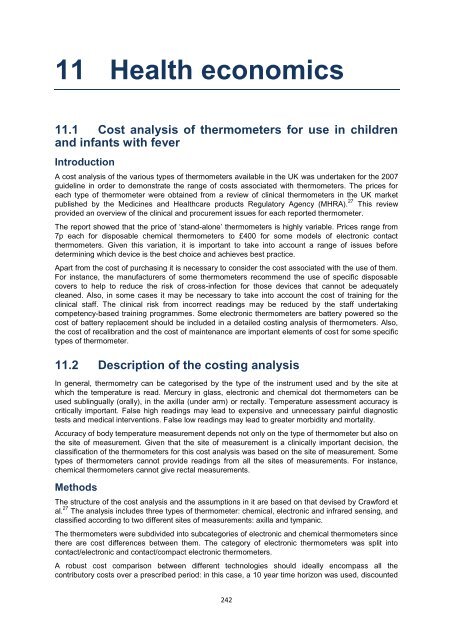A5V4d
A5V4d
A5V4d
You also want an ePaper? Increase the reach of your titles
YUMPU automatically turns print PDFs into web optimized ePapers that Google loves.
11 Health economics<br />
11.1 Cost analysis of thermometers for use in children<br />
and infants with fever<br />
Introduction<br />
A cost analysis of the various types of thermometers available in the UK was undertaken for the 2007<br />
guideline in order to demonstrate the range of costs associated with thermometers. The prices for<br />
each type of thermometer were obtained from a review of clinical thermometers in the UK market<br />
published by the Medicines and Healthcare products Regulatory Agency (MHRA). 27 This review<br />
provided an overview of the clinical and procurement issues for each reported thermometer.<br />
The report showed that the price of ‘stand-alone’ thermometers is highly variable. Prices range from<br />
7p each for disposable chemical thermometers to £400 for some models of electronic contact<br />
thermometers. Given this variation, it is important to take into account a range of issues before<br />
determining which device is the best choice and achieves best practice.<br />
Apart from the cost of purchasing it is necessary to consider the cost associated with the use of them.<br />
For instance, the manufacturers of some thermometers recommend the use of specific disposable<br />
covers to help to reduce the risk of cross-infection for those devices that cannot be adequately<br />
cleaned. Also, in some cases it may be necessary to take into account the cost of training for the<br />
clinical staff. The clinical risk from incorrect readings may be reduced by the staff undertaking<br />
competency-based training programmes. Some electronic thermometers are battery powered so the<br />
cost of battery replacement should be included in a detailed costing analysis of thermometers. Also,<br />
the cost of recalibration and the cost of maintenance are important elements of cost for some specific<br />
types of thermometer.<br />
11.2 Description of the costing analysis<br />
In general, thermometry can be categorised by the type of the instrument used and by the site at<br />
which the temperature is read. Mercury in glass, electronic and chemical dot thermometers can be<br />
used sublingually (orally), in the axilla (under arm) or rectally. Temperature assessment accuracy is<br />
critically important. False high readings may lead to expensive and unnecessary painful diagnostic<br />
tests and medical interventions. False low readings may lead to greater morbidity and mortality.<br />
Accuracy of body temperature measurement depends not only on the type of thermometer but also on<br />
the site of measurement. Given that the site of measurement is a clinically important decision, the<br />
classification of the thermometers for this cost analysis was based on the site of measurement. Some<br />
types of thermometers cannot provide readings from all the sites of measurements. For instance,<br />
chemical thermometers cannot give rectal measurements.<br />
Methods<br />
The structure of the cost analysis and the assumptions in it are based on that devised by Crawford et<br />
al. 27 The analysis includes three types of thermometer: chemical, electronic and infrared sensing, and<br />
classified according to two different sites of measurements: axilla and tympanic.<br />
The thermometers were subdivided into subcategories of electronic and chemical thermometers since<br />
there are cost differences between them. The category of electronic thermometers was split into<br />
contact/electronic and contact/compact electronic thermometers.<br />
A robust cost comparison between different technologies should ideally encompass all the<br />
contributory costs over a prescribed period: in this case, a 10 year time horizon was used, discounted<br />
242


